PROTECT YOUR DNA WITH QUANTUM TECHNOLOGY
Orgo-Life the new way to the future Advertising by AdpathwayJust two weeks after unveiling their first fully wireless drivetrain, XTR Di2, Shimano followed up with two waves of trickle-down tech in the mid-range XT and entry-level Deore lines. We got our mitts on the new Shimano XT Di2 before its official launch to dig in and see what gives. Find our first-ride review here, including details, weights, pricing, and 10 key takeaways from our time with the group…
At the time of publishing, it’s only been 14 days since Shimano pulled back the curtain on their long-anticipated, top-tier XTR Di2 group, debuting the brand’s first fully wireless drivetrain. Now, they’ve followed it up with two new lower-tier options that pack much of the same tech under the hood—a classic trickle-down move from the bike industry playbook. Still, the turnaround here might set a new record: drivetrain rollouts typically take months, if not a full year, to filter down. The new Deore Di2 and Deore XT Di2 groups (which I’ll refer to as XT Di2 from here on out) share a lot of the same DNA, functionality, and form factor as XTR, minus the polished aesthetic finish and a few small details.
I had a chance to install and test a fresh-off-the-boat Shimano XT Di2 group ahead of yesterday’s launch, and in this review, I’ll break down the pricing and weights across all three new Di2 groups, detail the key differences between them, and share nine realizations I had while riding and wrenching on the XT kit.
Pricing
If you came here hoping for a major price drop, let’s get the bad news out of the way first. In many cases, second-tier components come in at 25–35% less than their top-shelf counterparts. For instance, when GX AXS launched in 2021, the derailleur and shifter were exactly 25% cheaper than the sleeker X01 versions. However, when comparing XTR Di2 to XT Di2, the price gap is much narrower—a roughly 15% drop might not be enough to convince many people to open their wallets. Note that these prices don’t include the battery and charger.
| Derailleur | $390 | $400 | $550 | $538 | $435 | $570 | $665 |
| Shifter | $150 | $150 | $150 | $229 | $140 | $190 | $220 |
| Crankset | $199 | $200 | $300 | $377 | $125 | $263 | $460 |
| Cassette | $231 | $250 | $400 | $415 | $115 | $195 | $500 |
| Chain | $36 | $50 | $100 | $64 | $30 | $62 | $85 |
| Totals | $1006 | $1050 | $1500 | $1623 | $845 | $1280 | $1930 |
That said, there aren’t many differences between the two, which I’ll outline shortly, and both share the same internals and tech, aside from a few minor bells and whistles. Deore, on the other hand, comes in at about 35% less than XTR and includes a few more functional trade-offs.
Deore Di2 6200 Snapshot
Unlike XT and XTR, the only updates in Shimano Deore Di2 are the derailleur and shifter—consisting of a wireless derailleur, wired e-bike derailleur, and shift switch—keeping things simple and cost-effective. It’s cross-compatible with all Shimano 12-speed mountain bike cranks, cassettes, and chains. The wireless derailleur features a steel pulley cage, adding some weight, and the shifter uses single-click paddles that aren’t individually adjustable or rubberized, signaling a more budget approach. Unlike XT, there’s no mid-cage option or 9-45T cassette compatibility; it’s only operable with a 10-51T cassette. Still, like its higher-end siblings, Deore Di2 is made in Japan, and it delivers the same core performance with a few tradeoffs in materials and features.
Weights
As for weights, there also aren’t big contrasts between the core components. The bottom line is really more affected by the expendable commodities, such as cassettes. Unfortunately, the Deore Di2 weights aren’t published yet, but hopefully we’ll find out the details soon. We’ll be sure to tack them in this chart when we get them.
| Derailleur | 282g | 240g | 452g | 489g | 470g | 390g | TBD | 471g | 414g |
| Shifter | 135g | 112g | 80g | 70g | 48g | 82g | TBD | 97g | 101g |
| Crankset | 645g | 595g | 635g | 734g | 623g | 471g | 778g | 596g | 596g |
| Cassette | 473g | 367g | 453g | 446g | 381g | 354g | 595g | 463g | 364g |
| Chain | 252g | 242g | 244g | 284g | 262g | 260g | 279g | 252g | 242g |
| Totals | 1787g | 1556g | 1874g | 2023g | 1784g | 1557g | TBD | 1879g | 1717g |
Shimano XT Di2 (M8200)
The new Shimano XT Di2 group features long- and mid-cage wireless derailleurs, a corresponding shift switch, a trail-enduro crankset, and a new brake system, plus a few other bits and pieces I won’t cover here (a wired e-bike derailleur, alloy wheelset, and updated hubs with new seals and other details). The Di2 wireless components share core functionality with the XTR group Neil reviewed and are compatible with all Shimano 12-speed MTB cranks, cassettes, and chains. I’ll dive into each, but in a nutshell, the XT Di2 group has (mostly) the same responsive shifter with “2Step” double-click shifting. The XT derailleur trades XTR’s carbon cage for alloy, and the group includes a versatile crankset in four lengths (160 to 175mm) and chainrings from 28 to 36T.
Shimano XT Di2 Switch (SW-M8250)
If you checked out Neil’s review, which I highly recommend as a primer, I’d echo all the same glowing compliments he gave the XTR Di2 Shift Switch for the XT version. The differences between the two are subtle. Both feature textured rubber levers that feel like proper mechanical levers—not buttons—and they’re adjustable. Each one has a 3mm Allen bolt that allows the lever to rotate on multiple axes, almost like a ball-and-socket joint. I still found myself bumping the lever accidentally now and then, but I imagine that’s something I’ll dial in over time.
Both XTR and XT shifters also offer double-click functionality: a light press triggers a single shift, while a firmer press results in a double shift. I love this feature, and I’ll touch on it again in the realizations section. The main difference is that the XT shifter omits the external flathead mode switch found on the bottom of the XTR version, which allows riders to disable double-shifting entirely. I’m not sure why you’d want to turn it off, so I don’t consider this omission a downside. In fact, the XT Shift Switch is actually lighter because of it. If you’re eyeing Di2, save yourself 4 grams and 30 bucks and get the XT.
Shimano XT Di2 Derailleur (RD-M8250 SGS)
The XT Di2 RD-M8250 comes in two flavors: a mid-cage RD-M8250 GS that matches up with the 9-45T cassette, and the SGS I’m testing that’s designed for use with 10-51T cassettes. The RD-M8250 SGS is very similar to the XTR version with the same core internals, amorphic skid plate vibe, and general design. It also has the same battery interface and orientation, pulleys, and hanger.
As with past Shimano ranges, the primary distinctions between the two come down to materials, weight, and aesthetics rather than performance and functionality. The XTR derailleur gets all the shiny finishes, of course, while the XT is a more muted gray. The main structural difference is that XTR features a carbon pulley cage, and XT uses aluminum; that’s likely the main contributor to the 57-gram imbalance, although if it’s like past iterations, there are additional alloy bolts and axles swapped for steel on the XT version.
Shimano XT Crankset (FC-M8200)
The beauty of Shimano’s Di2 groups is that they’re all cross-compatible with each other and the brand’s mechanical 12-speed stuff. Plus, there are plenty of cranksets out there (or in your parts bin) that can be outfitted with Shimano 12-speed-compatible chainrings. You can run what you already have or pick up one of Shimano’s redesigned XT or XTR cranks, such as the FC-M8200. It’s a sharp-looking crankset, with relatively subtle graphics on hollow-forged 160, 165, 170, or 175mm arms and a 24mm steel axle.
Shimano mentions that the FC-M8200 was made for a variety of riding styles, including trail, enduro, and cross-country. The crank has a 176mm Q-factor and yields a 55mm chainline when paired with their direct-mount, zero-offset 28 to 36T chainrings.
Shimano XT Cassette (CS-M8200-12)
I didn’t get to check out the new XT M8200 cassette as it wasn’t available when they sent this group. Instead, I used the older CS-M8100. However, it’s worth noting that the 8200 got the same updated tooth profile as XTR M9200, with more material at the base of some teeth to improve durability, as well as the updated rivet structure to prevent the potential for creaking. And it’s lighter than the M8100.
XT M8200 Brakes (BL-M8220/BR-M8220)
Despite being last on my list, the new M8200-series brakes are undoubtedly a cornerstone of this group. Shimano released the BL-M8200 lever and two new calipers: the two-piston, XC-focused BR-MT805 and the one shown here, the trail/enduro BR-M8220. I won’t go into too much detail about the all-new Shimano XT brakes. Neil went into great detail in his review. But to summarize, the M8200 brakes got the same new low-viscosity fluid and seals, which aim to address temperature management and the inherent fading and bite-point issues. They also have a completely new cylinder and pivot point, which is 5mm closer to the bar, designed to help the lever track more naturally with your finger’s movement.
The most visible change is that the cables are routed closer to the handlebar, which looks cleaner, and fortunately for us, works much better with handlebar bags and rolls.
Comparing the M8200 series to the new XTR brakes, the weights are pretty close. Neil reported that his XTR front lever/caliper registered 307 grams, and mine came in at 314 grams. Aesthetically, they have different finishes, and the XTR calipers are made from a single chunk of aluminum, while the XT has a two-piece bolted structure.
10 Things I Learned
1. Tune In and Turn Off (E-Bike Mode)
Friend and longtime bike mechanic TJ Kearns helped me install the XT Di2 group and offered his perspective along the way. Habits die hard, and in classic bike mechanic fashion, we dug up some XTR Di2 setup notes and dove in without bothering to connect the derailleur and shifter to the app. Even so, setup was fairly straightforward.
Unlike SRAM’s T-type, the Di2 mechs install much like a wired derailleur using a hanger, a B-gap screw, and two limit screws. Once everything was dialed and trimmed, something still felt off. Shifting didn’t seem as crisp or fast as expected, particularly when moving the chain into the top three cogs. We called a buddy—who also happens to be the Shimano rep for the Southeast—and found out we’d missed three key steps: 1. Connect the derailleur and shifter to the E-Tube app; 2. Update the firmware to ensure the latest refinements are applied; and 3. Most importantly, disable e-bike Mode. E-bike Mode intentionally slows down shifting, and it seems to add an additional delay in the top two cogs so the chain can catch the ramps before making the jump—designed to protect the drivetrain under torque.
2. Long Live B-tension
Chances are, you either love or hate messing with limit and tension screws when setting up derailleurs. Either way, Shimano has kept them as a key part of the Di2 derailleur installation process, and I’m glad they did. I’ve always found Shimano derailleurs esay to dial in, especially with their built-in B-tension markings, which make setting the B-gap (the distance between the upper pulley and cassette cogs) fairly intuitive. It’s a far more streamlined approach than SRAM’s plastic B-gap gauges, with nothing extra to carry or potentially lose while out on a bike tour. If there’s one minor gripe, it’s that the alignment arrows could be white or more visible for easier reference.
3. You Can Trim While Riding
When initially setting up the derailleur, or just making micro adjustments for whatever reason, you can trim the derailleur to bring it perfectly into tune. To do so, you simply slide the button on the shifter over for five seconds until the yellow light illuminates on the derailleur. Once in trim mode, you can press the closer paddle to adjust the derailleur inboard, and the farther paddle to trim the derailleur outboard.
Better yet, you can do this while riding, if need be. On the SRAM AXS system, you have to hold down the button and push the paddle at the same time; that makes it a little tricky to do while pedaling around.
4. Shimano Di2 is Better for Travel
One thing that doesn’t get talked about much with SRAM Transmission is the torque spec. The precision of the T-type derailleur relies heavily on perfect alignment across the crankset, cassette, and derailleur. A friend of mine actually packed a torque wrench for our Slovenia West Loop ride to ensure he could properly torque the derailleur when rebuilding his bike. For context, he uses a soft-sided EVOC bike bag, so removing the derailleur is a necessity. What’s typically a five-minute task with a hanger-based derailleur becomes more involved with Transmission, which calls for a recommended torque of 35 Nm—a spec that’s critical for proper performance. This isn’t a concern with regular SRAM AXS or Shimano Di2 derailleurs, all of which use hangers. And as mentioned earlier, Di2 derailleurs feature a built-in B-gap mark, eliminating the need for a plastic gauge—something I always end up carrying on longer bike trips when running an AXS Eagle derailleur.
On a similar note, the Di2 battery charger is much more travel-friendly than the AXS charger. One, it uses USB-C cable, a standard I wish all electronics would adhere to. And second, it’s much smaller.
5. It’s Wildly Fast
As it happens, we installed X0 Transmission on another bike around the same time we set up the XT Di2 group. SRAM might not love hearing this, but when it comes to wireless shifting in the mid-to-upper tier range, Shimano’s implementation is miles ahead of AXS Transmission in terms of both speed and sound. Watch below:
6. Shift Switch Has Limits
In one sense, the shifting is almost too fast. You can literally stress out the derailleur if you have the number of gears to multi-shift configured to “No Limit” and the Gear Shifting Interval set to “Very Fast.” There’s a lot of configurability on this simple screen, however, and you can limit the number of multi-shifts to two or three gears, which I think is smart. I landed on limiting it to two, and it works extremely well with the two-position double click.
7. There Will be Slap
With the new crop of Di2 derailleurs, Shimano nixed their decade and a half old “Shadow Plus” one-way friction clutch. This mechanism did an excellent job at maintaining chain tension and reducing chain slap. However, it was problematic if not properly maintained. I was curious to see how their dual-spring clutch would perform and noticed that the cage seemed more easy to move and pliable (for lack of a better term) than that of SRAM’s AXS derailleurs.
One of the first things I observed on bumpy terrain was the occasional faint-but-audible clunk. As best I could tell, it was from the derailleur cage rebounding after the weight of the chain engaged the dual-spring clutch. After looking at several photos, the proof was there. Note that the chain was sized to Shimano’s specs, and as you can see the photos below, it’s on point. I plan on looking into this further, but it’s a notable downside, although not a deal breaker. Note that Neil reported that he hasn’t experienced this issue with the XTR Di2 derailleur.
8. Compatibility is King
The fact that XTR Di2, Deore Di2, and XT Di2 are all cross-compatible with each other and other cranksets offers plenty of interesting options. And as we pointed out in the XTR review, it’s also compatible with existing semi-wireless Di2 drop-bar systems; all three of the Di2 mountain bike derailleurs work with pre-existing drop-bar levers that were previously only partially wireless. Those include Dura-Ace 12-speed Di2, Ultegra 12-speed Di2, 105 12-speed Di2, and GRX 12-speed Di2, each of which featured wireless remote shifters with hard-wired derailleurs.
9. It may take some time
With the ubiquity of SRAM and the XD freehub, I wonder how quickly Di2 will catch on. Although Microspline is fairly common, SRAM has dominated the market for a while, and I’d bet a large percentage of wheelsets in use are equipped with XD freehubs. That means that a lot of people would need to fork over an extra $100 to $200 to upgrade to a Microspline freehub in order to make the switch. Additionally, there are probably many folks with several AXS batteries sitting around, which would be another stumbling block in the way of moving to a new ecosystem.
10. Shimano XT Di2 Deserves a Bump
As someone who’s always loved the unique feel of Shimano drivetrains—with a particular fondness for XT—it’s inspiring to see Shimano come out swinging with a refined shifter and derailleur system—and back-to-back trickle-down options that deliver lightning-fast, precise shifts. The backward and cross-compatibility is a big win, as is the fact that it retains the familiar look and function of a hanger-based derailleur. After playing catch-up in recent years, this launch could mark a well-earned step forward for the brand.
Pros
- Extremely fast shifting; nearly three times quicker than Transmission
- Very crisp and clean shifts—like a well-tuned mechanical XTR; the best shifting experience I’ve had to date
- All the classic derailleur tuning screws to get it dialed in
- No need for UDH
- Highly configurable via the E-Tube app
- Priced a little lower than XTR, and it’s compatible with other 12-speed components in the Shimano ecosystem
- Battery seems well-protected from water ingress
- Brakes feel great so far
- Stealthly housing routing is a plus for bikepacking
Cons
- Chain slap and chain movement is significant
- Shifter is easy to bump and mis-shift while hiking/snacking/etc.
- All the classic derailleur-tuning screws to get it dialed in
- Microspline Freehub isn’t as common as XD (yet)
- B-tension marker could be in white so it’s easier to see
- No forefinger trigger shifter
- Still expensive
What’s your take: does the new Shimano XT Di2 drivetrain look promising? Let us know in the conversation below, and keep an eye out for more thoughts on this group. In the meantime, you can find more details on the XT Di2 drivetrain and components at Shimano.com.
Further Reading
Make sure to dig into these related articles for more info...
Please keep the conversation civil, constructive, and inclusive, or your comment will be removed.


 3 weeks ago
13
3 weeks ago
13


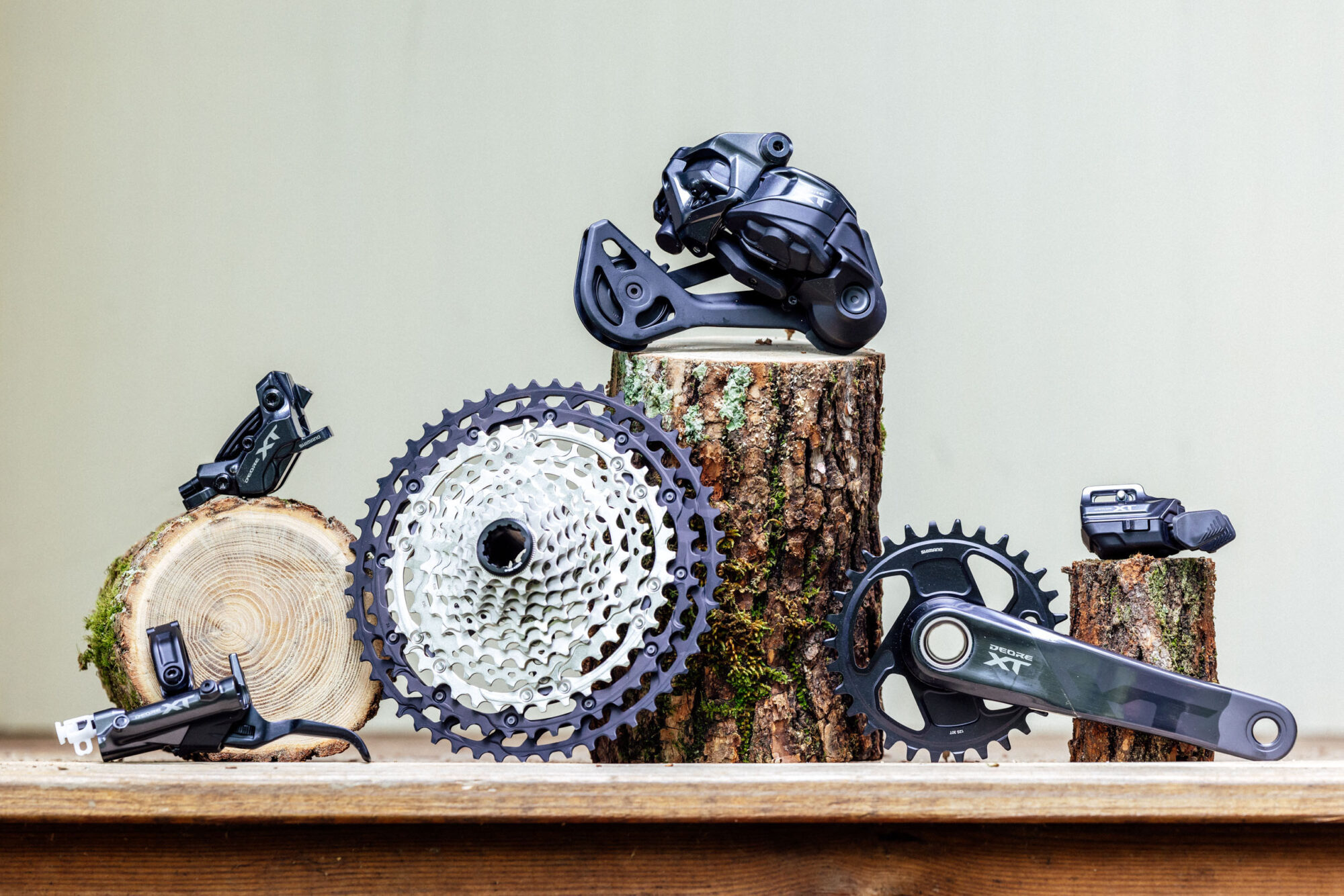
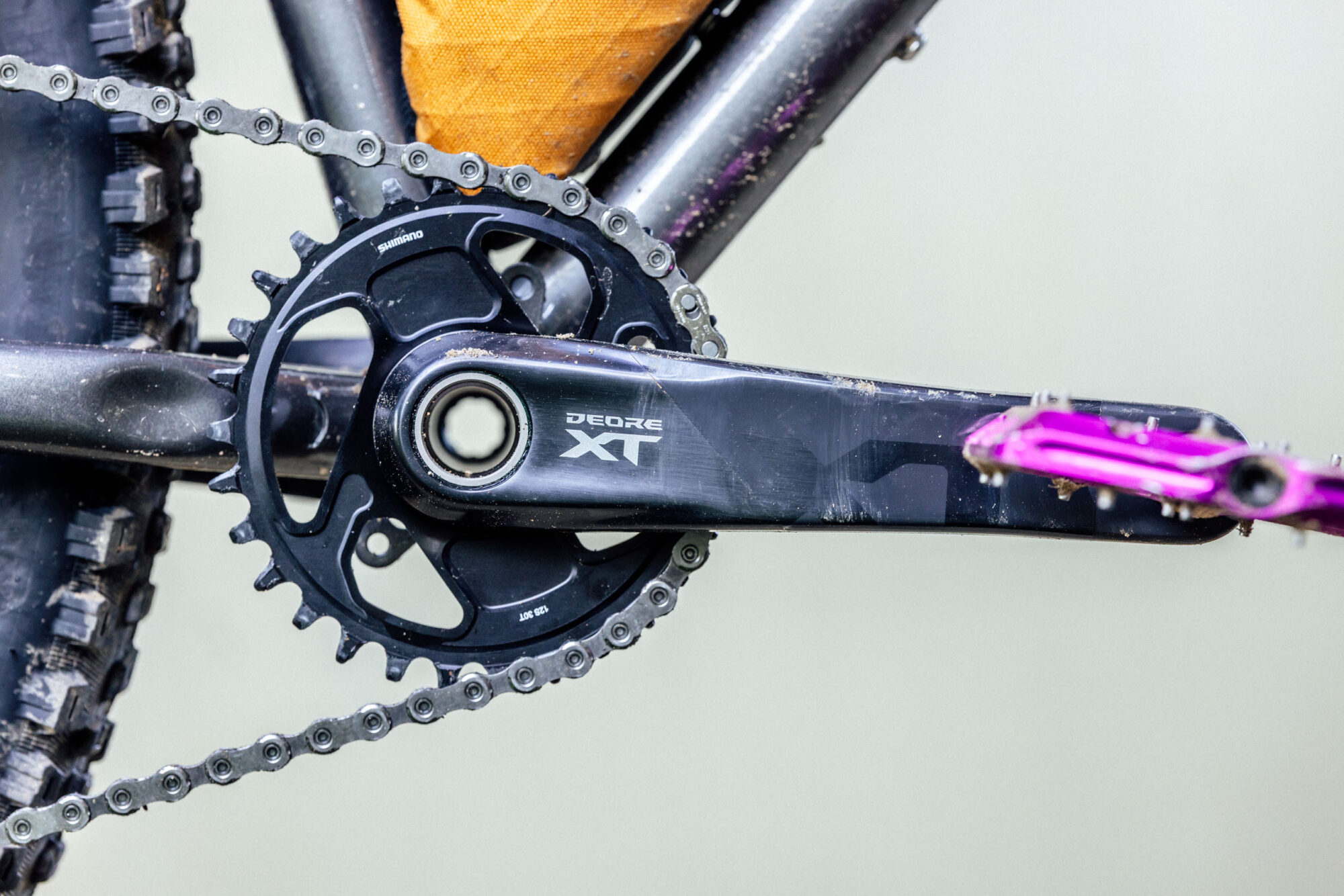



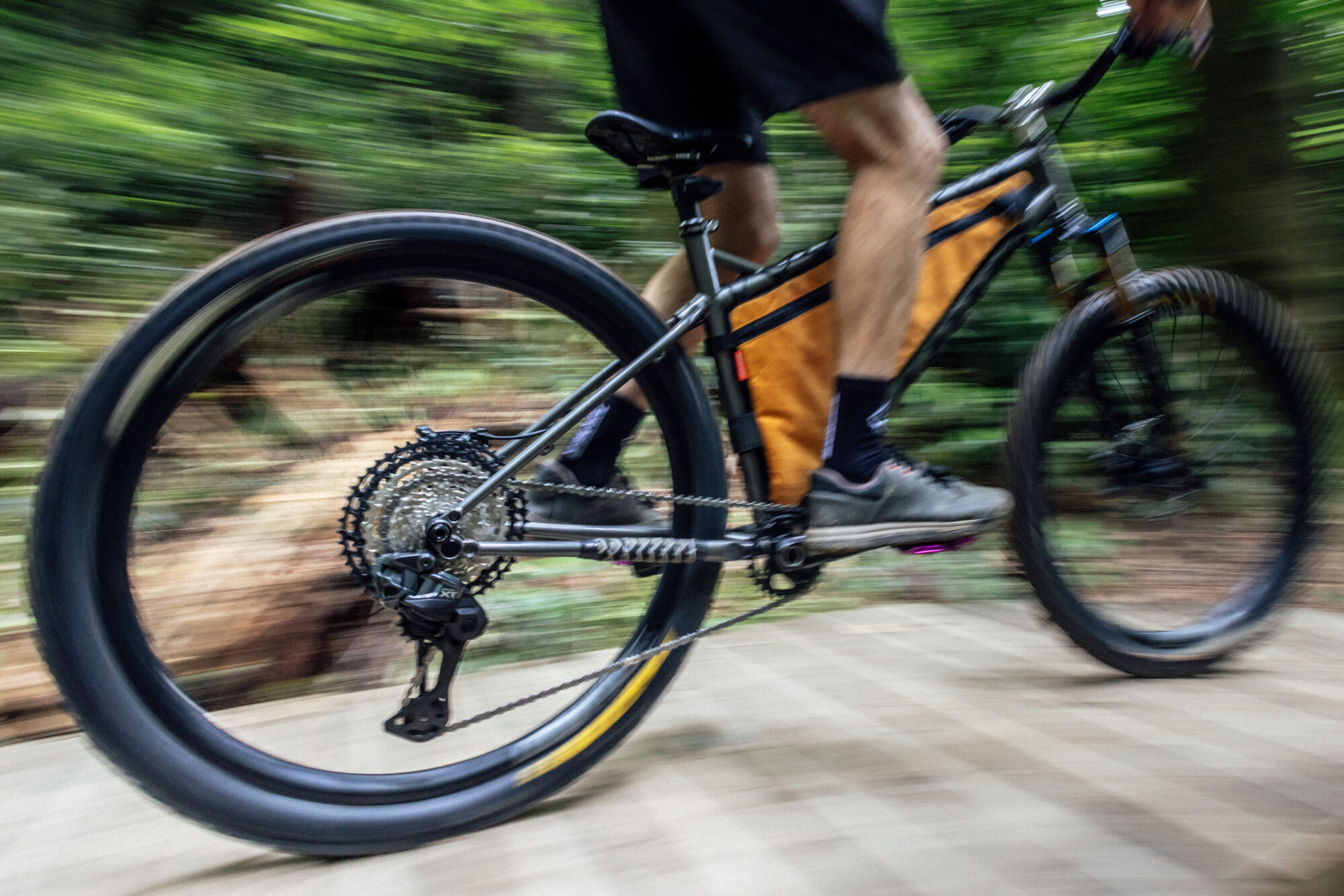

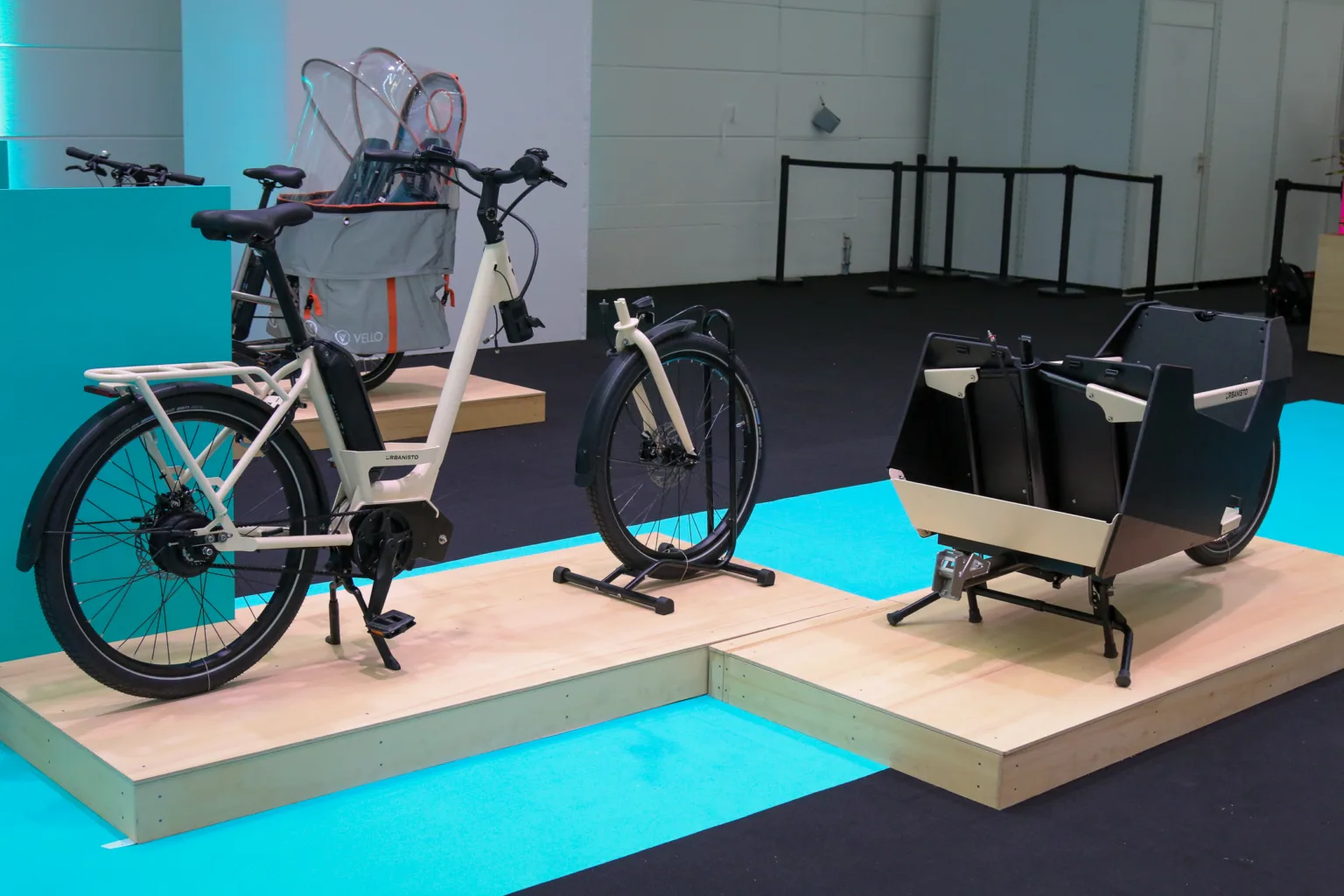

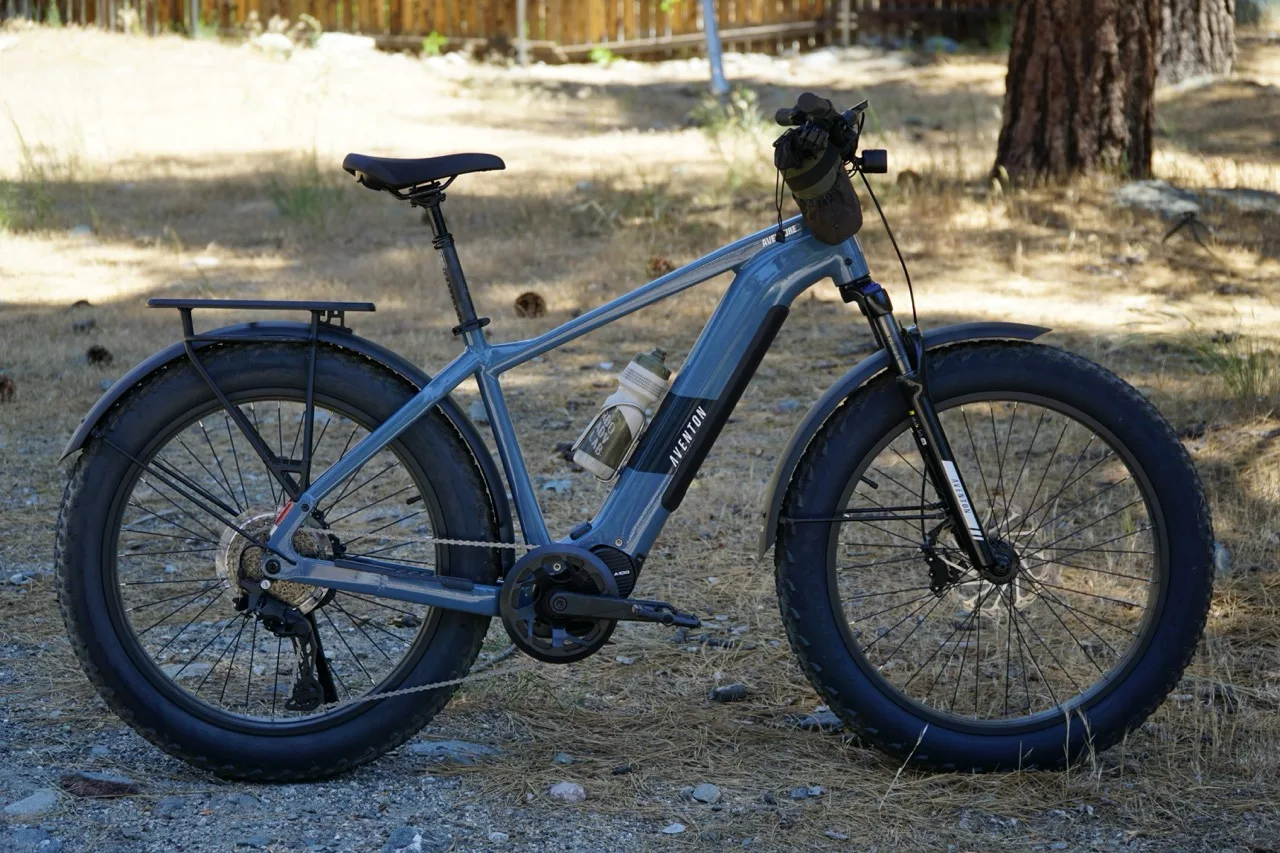
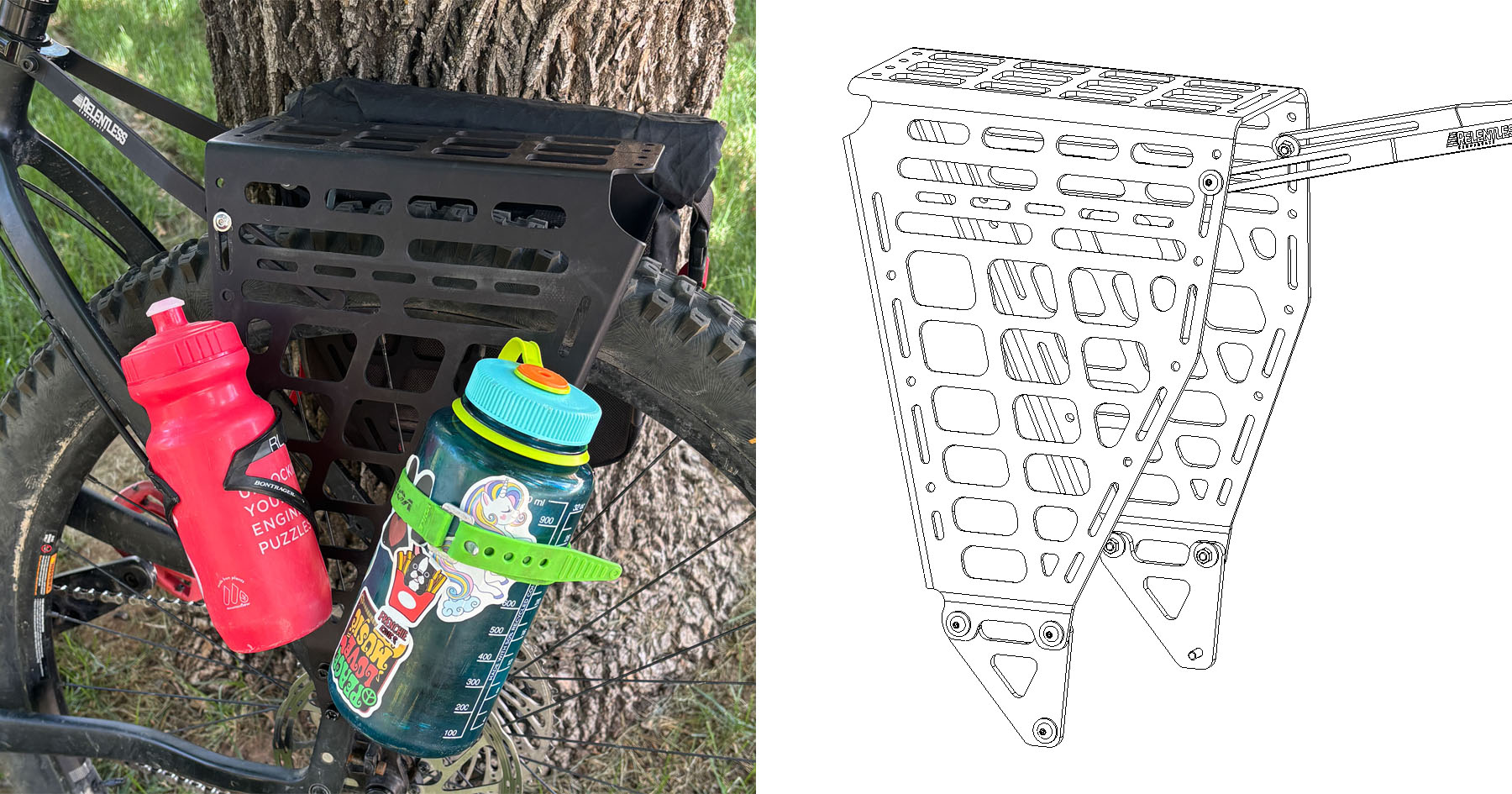
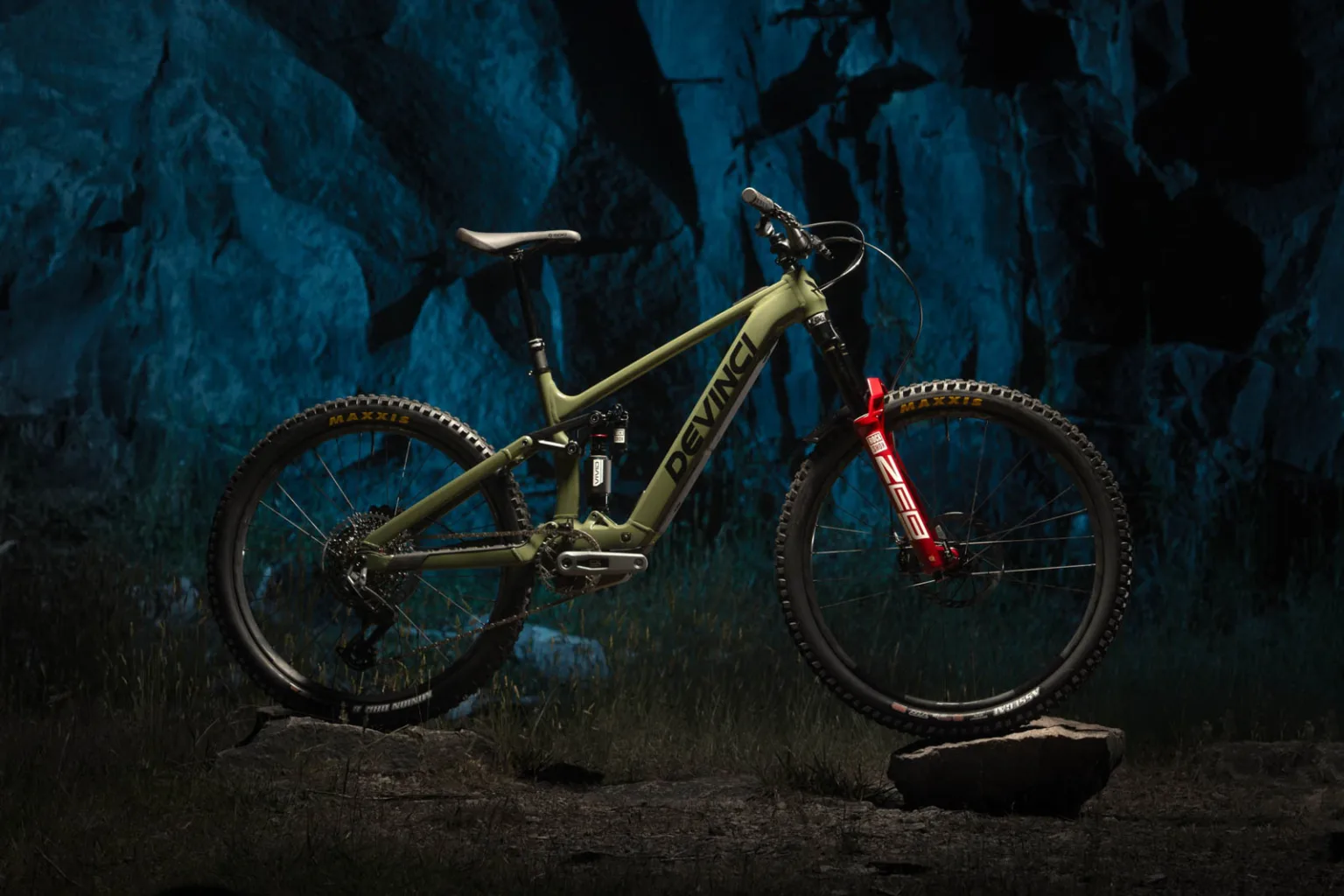

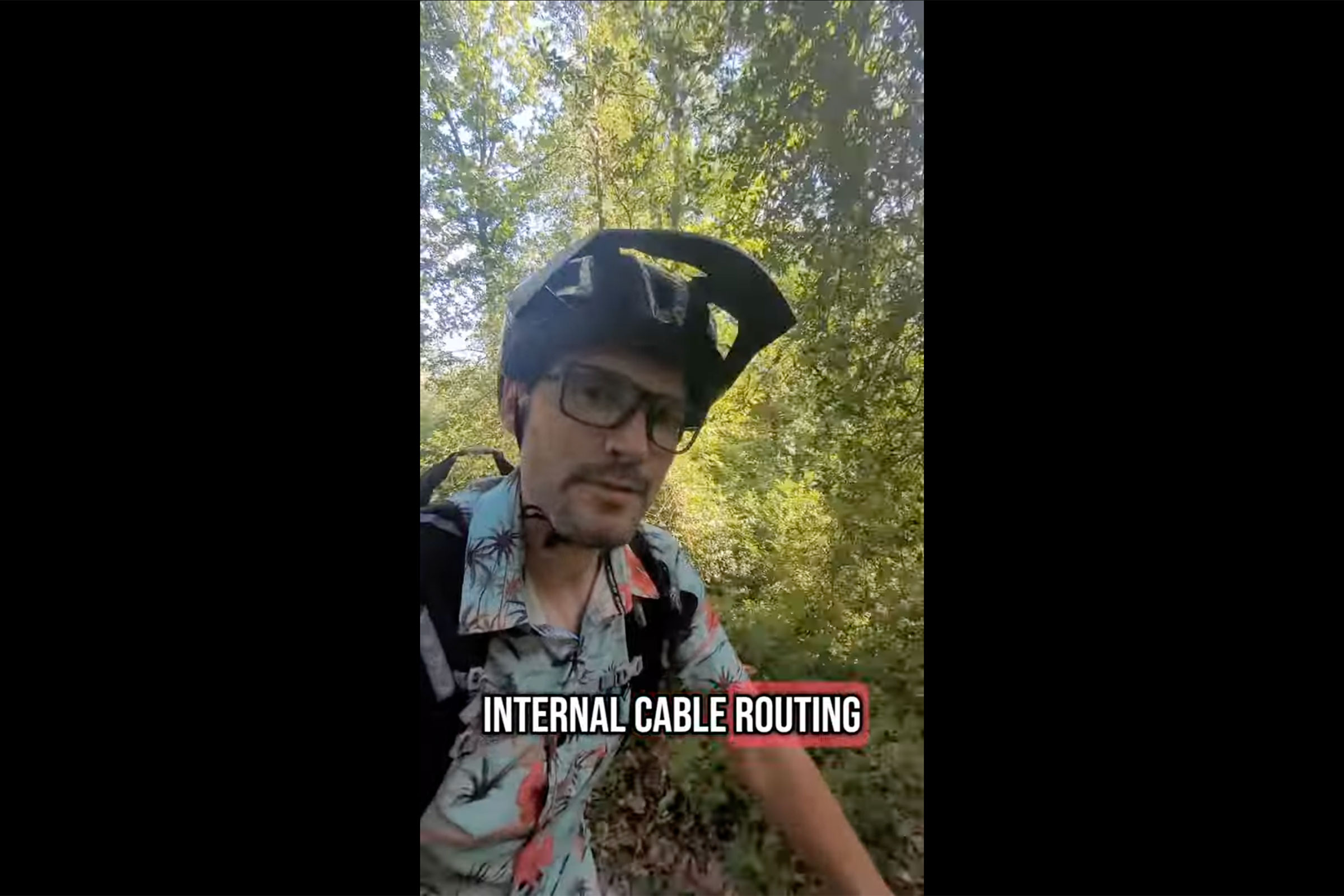


 English (US) ·
English (US) ·  French (CA) ·
French (CA) ·  French (FR) ·
French (FR) ·